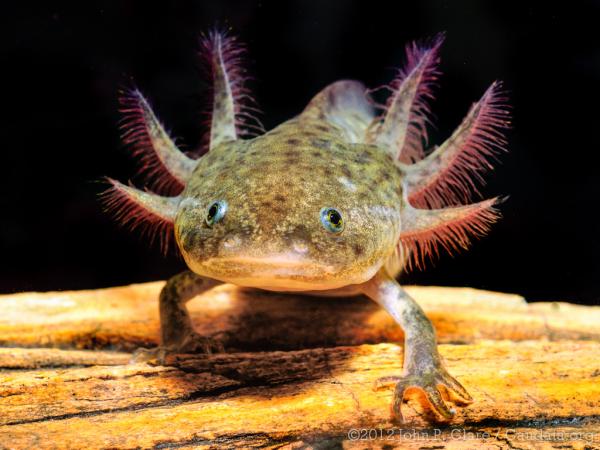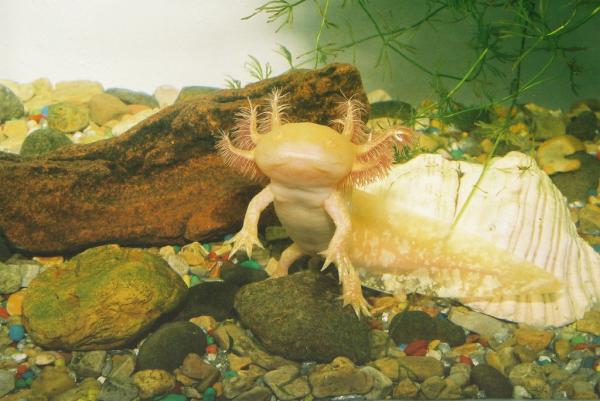Can You Take an Axolotl Out of Water?



See files for Axolotis
Axolotls are fascinating aquatic creatures that have become increasingly popular as pets in recent years. As amphibians, they are uniquely adapted to life in water and depend on it for survival. However, many pet owners wonder if it is safe to take their axolotls out of the water, either for cleaning or handling. While in some cases it is possible, it is important to know the risks and limitations involved to ensure the well-being of these unique animals.
In this AnimalWised article, you will find the answer to the question of whether axolotls can survive outside of water.
Where do axolotls live?
The habitat of axolotls is typically freshwater bodies of water such as natural or artificial lakes, rivers, or canals, and they do not live in the ocean. These waters have dense vegetation and muddy bottoms that provide abundant food sources and hiding places for axolotls.
Conditions in these habitats are also essential to the axolotl's reproductive cycle, as larvae require a liquid medium for development. Adult axolotls may remain permanently in the water or move to terrestrial ecosystems, returning to the water only to lay eggs.
Axolotls are native to central Mexico, particularly the Valley of Mexico, where they once lived in ancient Lake Xochimilco and Lake Chalco. However, due to urbanization and the introduction of non-native species, the axolotl's population in its natural habitat has declined dramatically in recent years, and it is now considered a critically endangered species.
In addition to their natural habitat, axolotls are also found in captivity around the world, as they are popular pets and used extensively in scientific research.
If you want to learn more about axolotls, check out this informative article on axolotl reproduction.

Can axolotls breathe air?
Axolotls are unique amphibians in that some species in the genus Ambystoma are neotenic, meaning they retain larval-like characteristics even when they reach adulthood. These include a dorsal fin that extends almost the entire length of the body, and three pairs of gills at the base of the head that point backward like feathers.
While some axolotls retain these larval features and live a life exclusively in the water, others undergo metamorphosis and develop into adults that can breathe through their lungs outside the water. These species may even live permanently on land, entering the water only to lay eggs, as the larvae require a liquid medium for development.
Axolotls are equipped with lungs, allowing them to breathe air, contrary to what some might believe. However, their primary method of respiration is through their gills, which extract oxygen from the water. Though axolotls may surface to inhale air directly into their lungs, this is not their main source of oxygen.
When axolotls are out of the water, their gills still function to some extent, but are not as effective as they are underwater. If axolotls are out of water for too long, they may inflate their gills as a sign of distress, as they cannot extract oxygen from the air with their gills.
In addition to their gills, axolotls use other means of breathing when they are out of the water. They can absorb some oxygen through their skin, and their lungs also provide a smaller portion of their respiration. Axolotls also have cheek breathing, which allows them to breathe with their cheeks.
However, these means of obtaining oxygen are not as effective outside the water and can only sustain axolotls for a limited period of time.
Are you interested in axolotls? Then you should not miss this other article about the diet of axolotls.

Can axolotls live on land?
Axolotls belong to the Ambystoma family, which is closely related to the salamander family. However, unlike many salamanders that can live both in water and on land, axolotls are primarily aquatic creatures due to some slight biological differences that evolved over time. Although axolotls can survive briefly out of water, they are not well adapted to living on land for extended periods.
The primary reason for this is because axolotls have gills for breathing and require water to extract oxygen. Furthermore, they are not very mobile on land and may have trouble finding enough food to sustain themselves outside of water. In contrast, some species of salamanders have lungs and are more adapted to life on land. Therefore, while some salamanders can live on land, axolotls are not well-equipped for extended periods of time outside of water.
How long can an axolotl survive on land?
The exact length of time an axolotl can survive on land may vary depending on several factors such as humidity, temperature, and individual health, but it is not a suitable environment for their long-term survival.

What do axolotls need in their habitat?
Axolotls are often kept as pets, and ideal habitat conditions are important to their health and well-being. Here are some key factors to consider for a domesticated axolotl's habitat:
- Water quality: axolotls need clean, fresh water to live. The ideal pH for their water is between 6.5 and 7.5 and the water should be free of ammonia and nitrites.
- Water temperature: Axolotls prefer water temperatures between 15 to 20 degrees Celsius (60 to 68 degrees Fahrenheit).
- Tank size: axolotls are relatively large aquatic animals and require a tank at least 20 liters in size. A larger tank is even better, as it gives the axolotl more room to swim and move around.
- Substrate: axolotls need a substrate that is soft and does not damage their sensitive skin. Sand, fine gravel or a tank with bare substrate are good options.
- Filtration: axolotls produce a lot of waste. Therefore, a good filtration system is essential to keep the water clean and healthy for them to live in.
- Hiding places: axolotls are nocturnal creatures and need hiding places to feel safe and secure. You can provide them with PVC pipes, rocks or decorations that will allow them to hide and rest.
- Lighting: axolotls do not require UVB lighting, but they do need a light source that mimics the natural day/night cycle to regulate their behavior and biological rhythms.
It is important to know that axolotls are sensitive to changes in their environment. Therefore, providing consistent and appropriate habitat conditions is critical to their health and longevity.
You may be interested in this other article, where we talk about different animals going through metamorphosis.
If you want to read similar articles to Can You Take an Axolotl Out of Water?, we recommend you visit our Facts about the animal kingdom category.
- SEMARNAT. (2018). Action Program for the Conservation of Ambystoma spp. Species , SEMARNAT/CONANP, Mexico. Available at: https://www.gob.mx/cms/uploads/attachment/file/444128/PACE_Ambystoma2.pdf
- IUCN. (2021). Genus Ambystoma . Available at: https://www.iucnredlist.org/search?query=Ambystoma%20cingulatum&searchType=species








